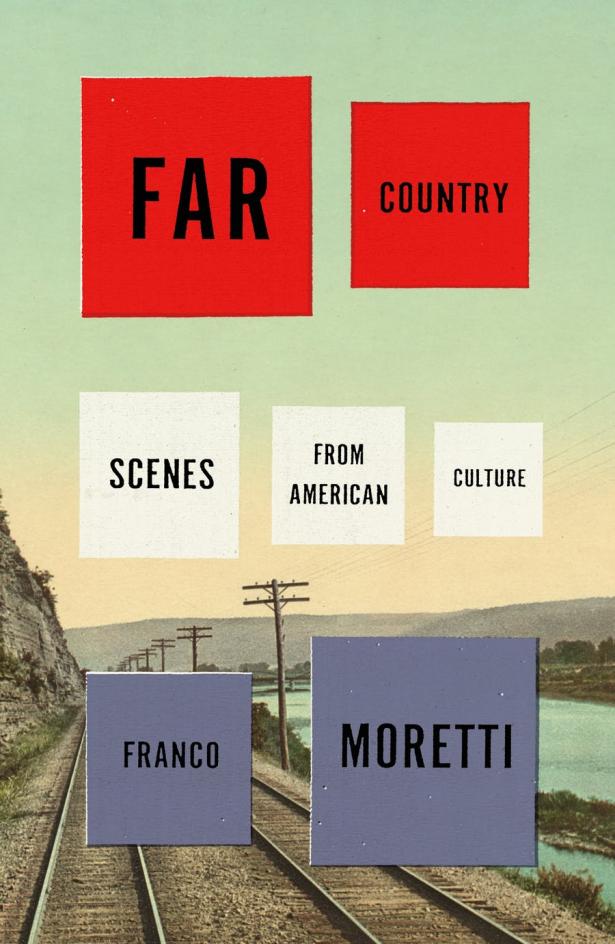Far Country
Scenes from American Culture
Franco Moretti
Farrar, Straus and Giroux
ISBN 9780374272708
Once upon a time, in a land far away, literature was an occult art: the product of singular inspiration arrived from an unknowable source. Each work was its own castle on a hill. The New Critics and their structuralist allies erected a barricade lest Marxist theorists, with confederates like the New Historicists, storm the enclave. These interlopers would build roads and bridges in all directions. Their goal was to forevermore connect works of art with the outside world, its history, economics, and social forces. In the melee, the wall was overrun and general chaos ensued; when the smoke cleared, there stood Franco Moretti.
This is not an accurate account of the progress of literary theory in the past 75 years, which logs more extravagant complexity than space allows. Suffice it to say that Moretti holds the standards of more than a few lit crit nation-states practically by himself, as well as banners of territory he alone has conquered. Applying a variety of data-driven or science-based methods not traditionally associated with art appreciation—geography, statistics, world-systems analysis, quantitative stylistics, historical materialism, computation—he takes a polymath approach to reading. Co-founder of the Stanford Literary Lab, Moretti has radicalized (some have said deadened) the way we can look at books. He coined the notion of “distant reading,” in opposition to the academy’s standard practice of textual close reading, and wrote an award-winning book of the same name; he literally put a century of European fiction on the map (An Atlas of the European Novel 1800–1900). It is rare in the field of literary criticism for an academic to have produced an even occasionally readable work, much less one that is more than occasionally delightful, but now in Far Country Moretti has done it.
There is an elegiac undertone to this admittedly “odd little book.” Recently retired from Stanford, Moretti aimed to memorialize some lectures from his course in Literary History in order that they might not do what lectures tend to do: vanish, “smoke in the wind.” Since they were a lot of work, he wanted to permanently engrave them for posterity, “Speaking from a university classroom” and not to one—in essence breaking the academy’s fourth wall. The effort may well also represent the desire to preserve a memento from a life now past. The reader becomes a student. For those who did not happen to attend Stanford, it is an opportunity to imagine what it might have been like to sit before a professor of pedagogical passion and supremely agile mind.
The structure of the course is as unconventional as his critical approaches, which together function as a comprehensive catalog—a Leaves of Grass, to take one example from Moretti’s panoramic consideration—of literary criticism.
Making the old, the trammeled, new again is (or should be) the purpose of criticism. If the work surveyed is good, it can sustain inquiry from every angle currently known, as well as any recently or yet to be invented. This is Moretti’s specialty, cannily exploiting digital capabilities for sorting data. A computational analysis of the “economic ideology” expressed in over a half century of the World Bank’s publications, published in “Bankspeak,” one of Moretti’s Lit Lab pamphlet series, uncovered the semantic and grammatical patterns marking contemporary “neo-liberal rhetoric.” It also made a fool of the institution’s chief economist, who was relieved of some duties after issuing an order to quell excessive use of the word “and.” Quantitative analysis of literature thus shows promise for effectual results, something that can rarely be said of traditional modes of criticism.
Far Country is indeed “short in pages, and compressed in style”: in under 135 pages, including illustrations, it offers a surprisingly extensive menu. And not only every flavor of literature (poetry, prose, drama) but film and painting too: Whitman vs. Baudelaire, an historical interrogation of Hemingway’s syntax, Death of a Salesman, the cinematic Western vs. noir, narrative in Vermeer, Hopper, Warhol. The reader’s epiphanies will likely follow suit and arrive in aphoristic form, too. Fed through Moretti’s multivalent interpretive machine, dozens of movies come out the other side of a few paragraphs as a gratifying realization: In the Western, everything is certain; in film noir, nothing is.
The conventions of these and the other genres under review in Far Country are ripe for quantitative analysis; after all, a convention is fundamentally a repetition. Interesting as that exercise is, though, Moretti uses quantification to spin insightful qualitative analyses. Discussing the notable accumulation of vast, unpeopled landscapes in the classic Western, the critic reveals the convention’s socio-political function. When native people are only made to appear after a place is “first seen” by whites, they are the ones rendered “illegitimate intruders.” In this way the Western acts as one big rationale for Manifest Destiny’s genocidal strategy: “Seldom has narrative lied so spectacularly about the history it claimed to narrate.”
Far Country sometimes reads as poetry– heightened language, packed meaning and all. It is decidedly not “beach reading,” nor is it without knots. Its pleasures are often chewy. (“But in art, causality is always teleology in disguise”: Moretti’s language is not difficult, but the thought can certainly be.) Its footnotes namecheck every heavy-hitter of 20th century literary theory, from Adorno, Bakhtin, Barthes, Benjamin, and Gramsci to Lukács. The book is not a story about stories. Its only moral is that syntax is everything: Moretti shows it to be the substructure supporting the form through which meaning is expressed. It is the artist’s decisive act.
Antagonists of Moretti’s novel criticism appear to believe art is a snowflake that melts under scrutiny. Instead of a structure built so solidly it is not only impervious to any method of dismantling but reveals the beauties of its design most fully in the attempt. Data analytics is not the enemy of art but its champion. In this small gem of a book Franco Moretti shows how.


Spread the word